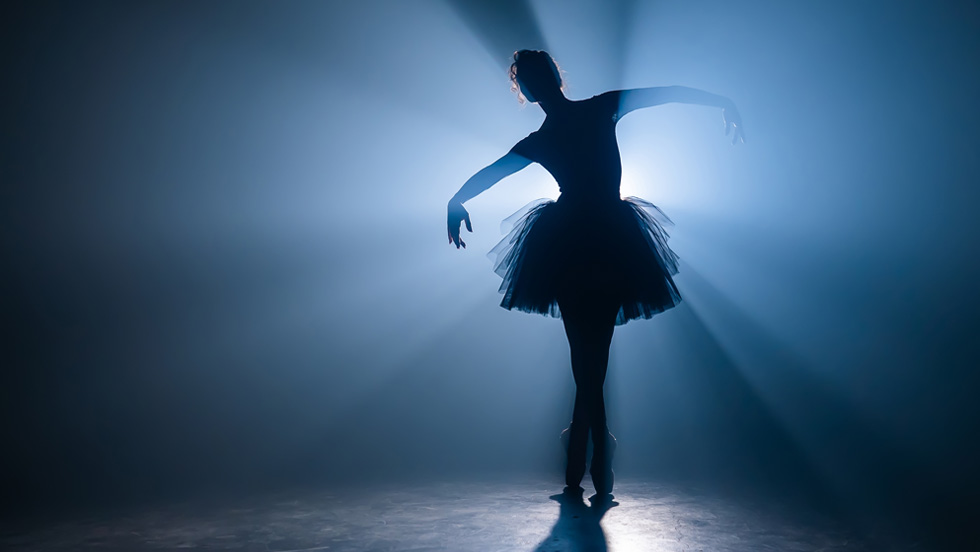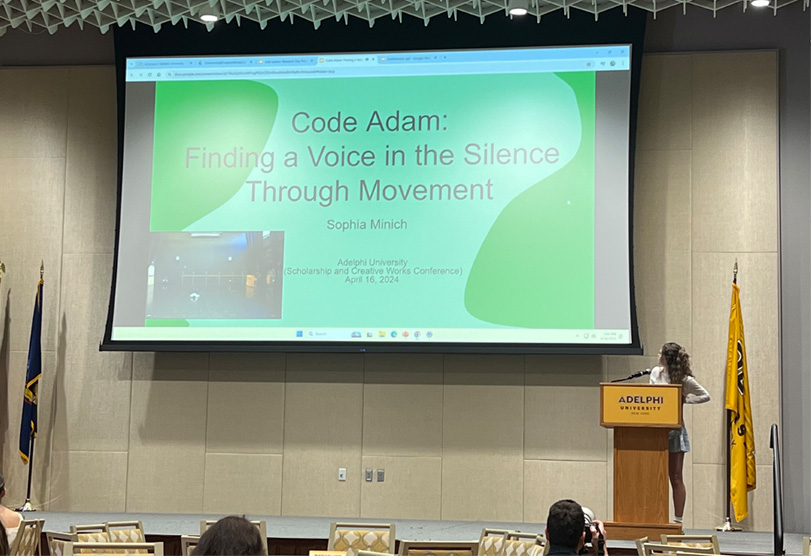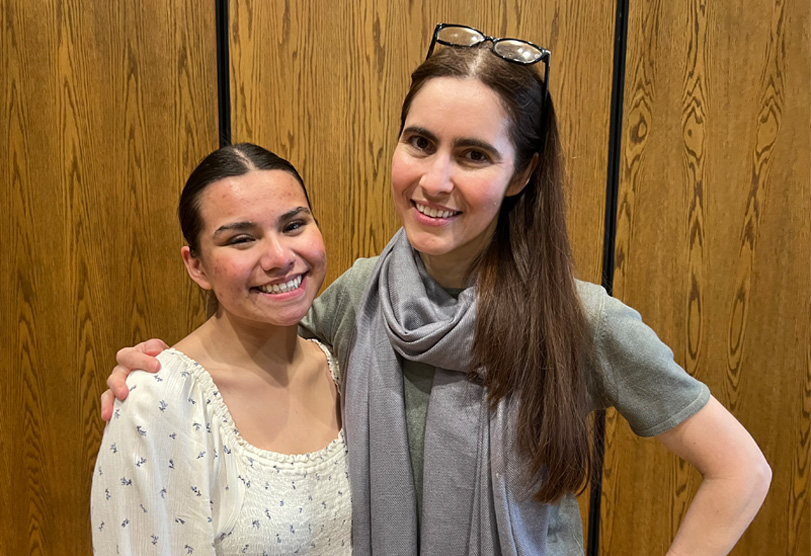
There are so many ways to dance, and a vast diversity of genres, techniques, styles and interpretations.
Adelheid B. Strelick, associate professor of dance at Adelphi University, encourages her students to add one more unique element to their performances: their voice.
As Strelick began the process of mentoring her dance students who planned to create performances for Adelphi’s 21st Scholarship and Creative Works Conference, she encouraged them to think about current social issues and contemplate how they could express their feelings about them through dance.
“We take time to do research, question what is happening in the world and explore issues through movement investigation,” Strelick said. “Together we use the dance studio as a movement research lab seeking how to express our views and opinions on things such as human caused climate change; equity; belonging; community; standing up for rights and freedoms; and challenging dance and its gender norms.”
The result? Deeply personal, evocative performances that tell a story—whether the student’s own, or a greater societal issue they care about.
The Foundations of Professor Strelick’s Exploration Through Dance
Strelick’s approach to teaching is grounded in the layers of inspiration she gained while earning her Bachelor of Fine Arts in dance at the Frankfurt University of Music and Performing Arts in Germany.
“When I was a student, I had the opportunity to witness one of the most important contemporary dance choreographers of the 20th and 21st centuries, William Forsythe, create work,” Strelick said. “Watching his process and observing his performance pieces shaped my understanding of what dance could be—his approach to how the audience engages with dance and how he challenges dancers by stretching the norms of what can be done on stage like talking, acting and singing.”
She was greatly influenced by how Forsythe modified the lines and recomposed notions of ballet aesthetics, challenging the viewer and the art form. Strelick was also exposed to European choreographers and companies that broadened her notions of where dance and theater intersect. She says that dancer and choreographer Pina Bausch, one of the most prominent creators within Tanztheater (dance theater), also influenced her aesthetics and beliefs about how one can approach creating works.
“Pina Bausch’s company featured dancers of all sizes, ages and styles, widening the vocabulary and possibilities of exploring dance on stage,” she said. “Her approach to choreography and its sense of humanity, social awareness and humility is something to which I am drawn.”
Strelick’s training in Germany provided an important base for the dancer and teacher she would become. She cites how the German dance/theater world’s openness to pushing boundaries and the cultural permission to take risks helped further the art form, allowing those who influenced her most to explore and challenge norms.
At Adelphi, Strelick teaches Ballet Technique, Dance History and Criticism, and Dance Theory and Composition, impressing upon her students the importance of bringing something of themselves—something new—to dance.
Making Statements on the Dance Stage
Students mentored by Strelick took on topics from imposter syndrome and political expression to missing children. Their time onstage at the conference not only reflected their dance skills but also the depth of their research and the poise of their presentations.
Clara Ossandón’s project, “Dance as Political Expression: A Poetic Act That Links, Heals and Unites That Which Was Separated,” was inspired by the death of Joan Jara, a Chilean British dancer and activist. Ossandón was struck by one of Jara’s statements: “Dance is a form of communication that is impossible to censor; the only way to do so is by persecuting the groups that dance.” She delved into this censorship in the context of her country, Chile, during its period of dictatorship 50 years ago.
“Jara’s reflection has a powerful meaning, representing dance as an act of resistance to social division and restrictions—more than simply creating an assignment, I wanted to challenge myself and take this opportunity to learn more about my background and process my life experience,” Ossandón said. “Through this process, I gained a deeper understanding and connection to my family’s and nation’s past.”
Ossandón also notes the interdisciplinary nature of her project: “I tried to connect my two majors and passions, dance and psychology. Processing life’s experiences through dance has enabled me to conduct research within the social, clinical and psychological domains and make correlations to the performing arts.”

With her performance at the Scholarship and Creative Works Conference, student Sophia Minich explored the topic of missing children.
Sophia Minich explored the topic of missing children in her research and performance. “Code Adam: Finding a Voice in the Silence Through Movement,” originated from a Dance Theory and Composition course and is the first of many works she hopes to create to highlight injustices toward missing people, specifically children. Minich’s research follows stories of those who have been silenced, repetitive behaviors that society continuously allows, as well as various compositional tools. Her choreography expresses through movement her research into specific missing children’s cases, both famous and not.
“Professor Strelick continues to open my mind as to what choreography and performance can be,” Minich said. “She has guided my work both directly and indirectly, offering tools and constructive feedback to help me further develop this piece and teaching me how important research can be in the arts.
Minich hopes to someday orchestrate a performance with all of the proceeds going to the National Center for Missing & Exploited Children or a similar organization. She said, “This piece is obviously only a start—there is so much more awareness to be raised and work to be done, but I would like to contribute through dance as it is such a powerful and emotional art form.”
Alena De Leon choreographed “Acknowledging Who I Am: Imposter Syndrome in Students” to take a deeper look at first-generation college students who share this persistent inability to believe that one’s success is deserved or has been legitimately achieved as a result of their efforts or skills. Inspired by her own life experiences as the child of a first-generation Mexican American, a key element of her performance is the gestural motif of taking off her shoes—representing the gratitude she feels toward her mother who she wishes could walk in her shoes.
“As a performer, I constantly embrace the responsibility of creating,” De Leon said. “The Scholarship and Creative Works Conference means a great deal to me because it is an opportunity to express why my compositions are important and to elaborate on my own narrative.”
De Leon’s study and choreography investigates the conflicting emotions of deep-seated gratitude coupled with a sense of unworthiness of opportunities. She says the importance of this study is in giving those who paved the way before her a voice. “As a Mexican American, I dance with two flags, and the weight of this is tremendous—it is my obligation to dig deeper and find a way to be recognized and achieve success.”
Research Brought to Life

Taking a break during the Scholarship and Creative Works Conference
The audience members gathered in the University Center ballroom for the Scholarship and Creative Works Conference were both moved and entertained while viewing the product of Strelick’s dance students’ research—as was she.
“I enjoy how students find their own voice and challenge themselves to go deeper into research to find their own unique way of being an artist in our contemporary moment,” Strelick added. “It is rewarding to see them grow through their artistry and discover themselves as part of a community, ultimately finding belonging.”